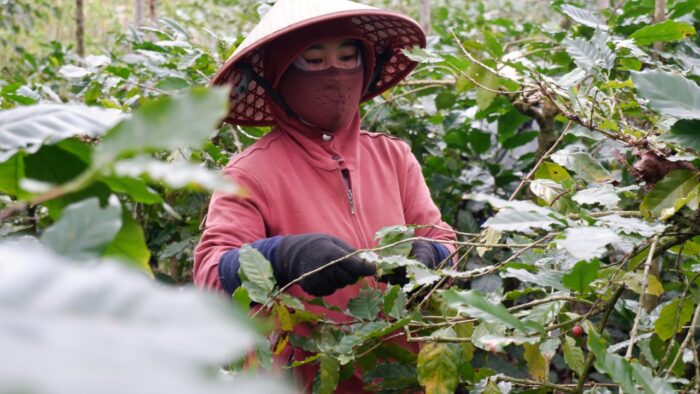By Dr. Steffen Schwarz | Coffee Consulate
Bir zamanlar Afrika ve Latin Amerika merkezli olan kahve üretiminin küresel haritası son yıllarda önemli ölçüde değişti. Yeni üreticiler öne çıkarak küresel arz dengesini değiştirdi ve kahve ticaretini yeniden şekillendirdi. Bu dönüşümün ön saflarında, hızlı yükselişiyle 20. yüzyılın sonlarındaki en çarpıcı tarımsal gelişmelerden birini temsil eden Vietnam yer alıyor.
In the 1980s, Vietnam played only a minor role in the global coffee sector. However, following sweeping economic reforms (Đổi Mới) and strategic government investment, the country’s Central Highlands became a hub for robusta cultivation. Production surged from just 91,000 tonnes in 1975 to around 1.8 million tonnes by the late 2010s, giving Vietnam a 17–18% share of global coffee output. In typical years, the country now produces between 27–30 million bags, nearly all of them robusta.
However, the 2023/24 season marked a significant downturn. According to the FAO, prolonged drought and extreme heat triggered a 20% decline in Vietnamese output. Many farmers also delayed selling their beans in anticipation of higher prices, creating an early-season supply squeeze for exporters.
Looking ahead, the outlook is more optimistic. Improved rainfall is expected to lift production to 29 million bags in 2024/25, and 31 million in 2025/26, reinforcing Vietnam’s role as the world’s top robusta producer. Export volumes, which were constrained in the first half of 2024/25 due to farmer stockpiling, are projected to rebound to 27 million bags by 2025/26.
Still, the boom comes with environmental costs. Vietnam’s coffee success has been driven by intensive monoculture and land expansion, practices now under scrutiny amid mounting climate pressures.
Beyond Vietnam: Other Rising Coffee Powers
Across Asia, Indonesia remains a major player. The country grows both arabica (Sumatra, Java, Sulawesi) and canephora (mostly in southern Sumatra). Though heavy rains reduced output by 16.5% in 2023, a recovery is underway. The USDA estimates 2024/25 production at 10.9 million bags, up from 8.1 million the previous year — including a significant 2.7 million bag increase in canephora.
Etiyopya, Afrika'da ağırlığının üzerinde bir performans sergilemeye devam ediyor. Hacim olarak dünya çapında beşinci sırada yer alsa da, arabica'nın doğduğu yer olarak rolü ona benzersiz bir önem kazandırıyor. Çoğunluğu küçük çiftçilerden oluşan Etiyopyalı çiftçiler 2025/26 yılında 11,6 milyon torba gibi rekor bir üretim gerçekleştirdi ve bunun yaklaşık yarısı yurt içinde tüketildi. Buna rağmen, kalite iyileştirmeleri ve çiftçilerin küresel pazarlara daha iyi erişimi sayesinde ihracat gelirleri tüm zamanların en yüksek seviyesi olan 2,6 milyar dolara ulaştı.
Uganda, too, plays a key role, particularly in canephora (which is native to its forests), with some arabica from the Mount Elgon highlands. Together, Ethiopia and Uganda anchor Africa’s contribution to global supply.
Central America and Beyond
In Central America, Honduras has emerged as the top producer, surpassing regional neighbors after recovering from a severe rust outbreak in 2012. It now consistently exports over 6 million bags annually.
Mexico, after years of decline, has stabilized production at around 4 million bags. Arabica output grew 5.2% this year, but canephora volumes plunged by a third after heatwaves damaged lowland plantations in Veracruz. These divergent trends underscore how climate variation affects each coffee species differently.
Across the globe, dozens of nations — including India, Peru, and more — contribute to the world’s coffee supply. Their ranks and outputs shift regularly, driven by economics, climate, and agronomic practices.
A Global Patchwork of Production
Today’s coffee production landscape spans:
-
Latin America: ~41% of global supply
-
Asya ve Okyanusya: ~%27
-
Africa: ~17%
Together, these regions form a dynamic, evolving matrix of farms — large and small — that power the world’s coffee consumption. As climate challenges intensify, and as market pressures shift, the titans of coffee production will continue to redefine the future of this global industry.
The post Kahve Üretiminin Yeni Titanları appeared first on Qahwa World.




